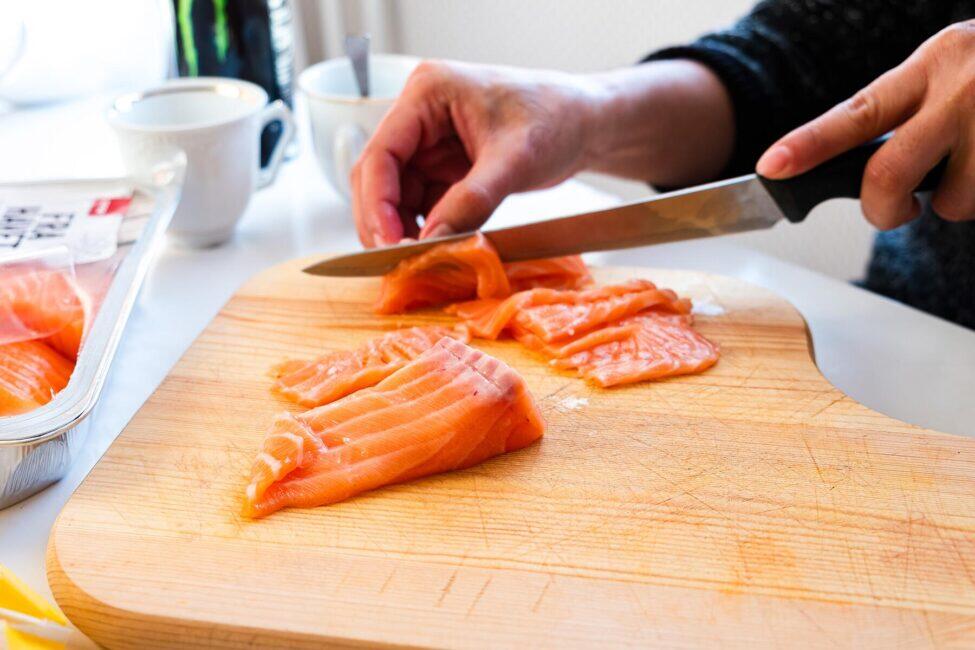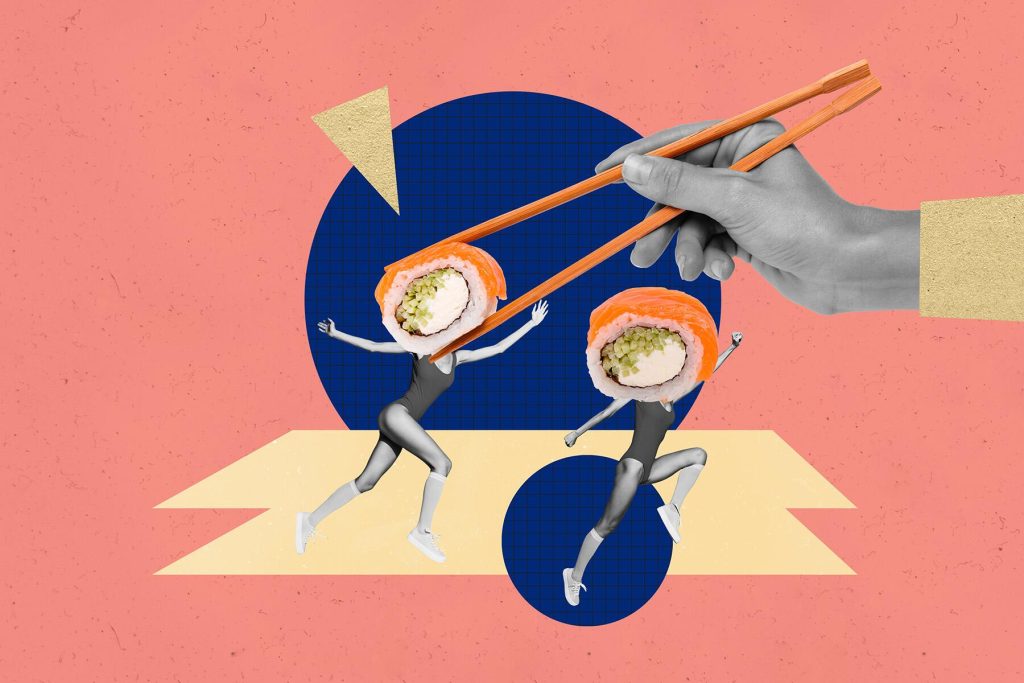Sushi in America almost didn’t happen.
People born in America in the ‘90s take their local spicy tuna roll for granted—but we ‘80s babies remember a depraved world in which eating raw fish was unheard of. We were alive when the rainbow roll almost didn’t make it to the Western Hemisphere—where the average suburban kid couldn’t name a single nigiri topping, and spicy mayo was not yet its own food group.
The globalization of sushi culture wasn’t inevitable. It hinged on a single, unexpected catalyst–not Japan and not even fish itself—a blue ocean strategy and branding campaign led by a Nordic country with too much salmon on its hands and no one to sell it to.
Norway’s Salmon Problem
In the 1980s, Norway found itself with a salmon problem. Decades of government subsidies and modern farming practices went head-to-head with a collapsing domestic market, as Norwegians began eating more meat and less salmon.
As both subsidies and demand dried up, Norwegian fishermen found their livelihoods disappearing. They began freezing huge quantities of unsold salmon. Prices fell so dramatically that in 1991, salmon farmers and the Norwegian fishing sales union folded, and banks lending in the sector came under significant financial pressure. The salmon bubble was bursting.
Continue Reading Article After Our Video
Recommended Fodor’s Video
The Japanese Solution
A fortuitous visit to Tokyo in 1985 introduced Norwegian Fisheries Minister Thor Listau to a Japanese market in need of a new source of fish. Before this era, Japan had been self-sufficient in terms of its fish supply, but was beginning to look outward for new sources as its tuna stocks—always the sushi frontrunner—were becoming strained due to a convergence of pressures including overfishing, new fishing regulations, and rapid population increase.
Listau homed in on this market gap. Why wouldn’t Norway’s Atlantic salmon be the perfect substitute for Japan’s dwindling tuna supply? Not only were the Japanese looking to supplement their domestic market for the first time, but their traditional manner of eating fish—raw, of course—fetched market prices three to 10 times higher than those of fish slated to be cooked.
In practice, however, Japanese environmental factors dictated that salmon was absolutely never eaten uncooked. In fact, the Japanese didn’t even like to touch raw salmon because Pacific salmon carried parasites known to cause a condition called anisakiasis, which symptoms include sudden, severe stomach pain, often with nausea and vomiting.
Norwegian salmon was another story. Cold water farming practices kept it clean of parasites, but breaking down cultural associations with food health isn’t as easy as telling someone that your salmon is safe to eat.
Japanese food consultant and TV host Marc Matsumoto remembers the complete disinterest in raw salmon in the ‘80s, equating Japan’s stigma toward eating it raw to Americans’ lack of interest in eating raw chicken, “which we do here in Japan,” Matsumoto tells me.
The salmon aversion was so ingrained in Japanese culture that simply getting rid of the health risks wasn’t enough to create a market. And even when they did get the more adventurous Japanese to try it, Norway’s fatty Atlantic salmon was just too foreign to them. Japanese would-be early-adopters felt the fattier quality and the resulting aesthetic was “off.” They didn’t like the color, the smell, the texture, the flavor… they even hated the shape of the fish’s head. The Japanese just didn’t like raw salmon.
Project Japan: A Blue Ocean Strategy
Where most would have found this barrier to entry too high, Listau was undeterred. Rather than searching for a more suitable market, he launched a government-led effort to convince the most tradition-bound culinary culture in the world not only to eat a fish they considered a health hazard, but to eat it raw. He called it Project Japan.
Operating under the assumption that Japan’s aversion to Atlantic salmon was purely from association, rather than some deep-seated biological preference, the marketing campaign’s high-level strategy was basically to get the Japanese to try Norwegian salmon enough times until they liked it as much as the Norwegians did. The end goal was ambitious—to create a new market for Atlantic salmon as a staple in Japanese sushi. The man set to run it? A Norwegian aikido black belt with a lifelong obsession with Japanese culture.
Bjørn Erik Olsen—Even More Ambitious Than the Last Guy
Bjørn Eirik Olsen’s fascination with Japanese culture began when he saw the black-and-white Japanese film, Seven Samurai, at age 11. That fascination led him to study Japanese, live in Japan, and train in the martial art of aikido. In the early 1980s, he received a Japanese state scholarship and immersed himself in the language, the culture, and the seafood industry. With one foot on each continent, Olsen launched a version of Project Japan even more ambitious than Listau’s.
The Japanese weren’t opposed to eating salmon generally, and actually wanted to buy some of Norway’s stocks. But from their perspective, they were buying a low-quality fish for grilling or even frying. This wouldn’t yield premium raw fish prices that Olsen was after, and it would have put Norway in direct competition with the Japanese seafood industry. Olsen wanted to sell a premium product, and he wanted longevity in the market, which required Japan to be a trading partner, rather than a competitor. He wanted to “cooperate, not compete, with the Japanese industry.”
As a marketer, I can tell you that a centuries-old distaste for the product in question is too formidable a hurdle for most people in the industry—but for Olsen, it was just a friction point. He was patient, ambitious, and confident that he could change tradition through marketing and time. “We had to make Norwegian salmon something it had never been before in Japan: raw, fresh, and desirable.”
Branding Campaigns and Influencer Marketing
Under Olsen’s command and with Norway’s fisheries ministry and seafood exporters, Project Japan hosted tastings at the Norwegian Embassy in Tokyo, where they experimented with salmon in sushi dishes. They served this new European-style sushi to importers, restaurants, and dignitaries. They put on industry events in Tokyo and deployed influencer marketing with notable chefs, like Chef Yutaka Ishinabe, famous for starring in the first season of Iron Chef. They managed to win a few hearts and minds, here and there, but it wasn’t enough.
Six years, a retired Viking caricature mascot, and a number of failed marketing campaigns into Project Japan, Norway still hadn’t convinced Japan to change its culinary preferences to accommodate the Norwegian market’s needs. So in 1992, Olsen doubled down.
He brokered a deal with major food distributor, Nichirei, by offering substantially below-market prices on 5,000 tonnes of Norwegian salmon on one condition—that it only be sold for sushi. Nichirei accepted, making it the first major Japanese company to commit to salmon as a sushi-specific ingredient. “If we could just get people to try it,” Olsen says, “I knew it would be a success.”
Olsen took this opportunity to double down on a rebrand. He asked Japan to call the imported Norwegian salmon “Noruē sāmon,” using transcribed English instead of the usual Japanese sake (鮭)—completely disassociating the European product with its undesired Japanese counterpart.
Hiroshi Niwa, then head of the Norwegian Trade Council, found some adventurous chefs to begin experimenting with Norwegian salmon in their sushi dishes while Project Japan ran ad campaigns for “Noruē sāmon,” which often included imagery of the pristine Norwegian fjords—a softer approach to conveying cleanliness than using the tagline “parasite-free.”

Appealing to the Consumer
After Japan’s asset price bubble burst in the ‘90s, expensive sushi restaurants suddenly found themselves met by a price-elastic consumer. Sushi had always been somewhat of an expensive meal, primarily eaten in restaurants, where the labor-intensive preparation utilized economies of scale.
Conveyor belt sushi restaurants rose to the occasion, providing a solution by maintaining lower costs, and sushi boats quickly became popular among Japanese families. More importantly, it allowed Norwegian salmon to reach consumers unfettered by food industry experts steeped in bias. The conveyor belt effectively minimized Japanese seafood industry professionals’ role as gatekeepers of what is good sushi, and let the customer decide what they liked.
Spoiler alert: it was salmon.
Olsen said that his team discovered a negative correlation between knowledge about the seafood industry and preference for raw Norwegian salmon. “The children had no prejudices. They saw that salmon had a nice colour and picked it from the belt,” Olsen says. This direct-to-consumer supply chain was hugely successful in changing the Japanese perception of raw salmon, where today, 59% of Japanese consumers dining out prefer salmon raw in sushi. As Project Japan got closer to the consumers, the industry followed.
An Unintended Market
I remember the sushi restaurant in Sacramento, California, where I grew up in the ‘90s. Like many towns at that time, we had only one. Tokyo Sushi was in a strip mall and had little boats that went around a conveyor belt on a mini river. You would pick up a tiny dish with two pieces of nigiri. It wasn’t fancy, but I loved it, as did most Americans, but this kitschy middle-class fad was more than a gimmick.
While Olsen was focused on Japan, making Norwegian salmon a staple in sushi came with an unintended result. Now that this fatty fish with a palatable texture and flavor was the mainstay of Japanese sushi, the Western palate didn’t find sushi to be so foreign and, as you’re well aware, absolutely loves it. Salmon—with its mild, fatty, and approachable flavor profile—was the gateway drug for American sushi fanatics and the catalyst for the 1990s sushi boom in the U.S. and the world.
Today’s Norwegian Atlantic salmon is one of the most widely consumed fish globally. In 17 out of 20 countries studied, salmon is the most preferred sushi topping. Over time, Norway has restructured its salmon supply chain and today, it exports to 113 countries and holds 53% of the global salmon market, with 30% of it being eaten raw.
A Meal in Itself Chef Matsumoto says that eventually, the “clean, buttery flavor of Norwegian salmon” won him over, but it took a decade of marketing and menu placement before salmon sashimi felt “normal” to him. “I still see how cultural memory lingers in older generations’ tastes,” he tells me.
Sushi became popular in America in part because Bjørn Eirik Olsen decided a centuries-old culinary culture could be persuaded through a blue ocean strategy, a rebrand, and a little patience. “The challenge… was not in the product, it was in people’s minds,” says Olsen. “Changing the perception of 120 million conservative Japanese seafood lovers was bound to take time.”
From a glut of fish in Nordic waters to sushi boats in California strip malls, Olsen’s gamble didn’t just change Japan—it changed how the entire world eats.

